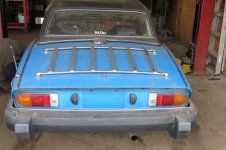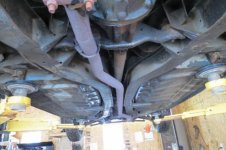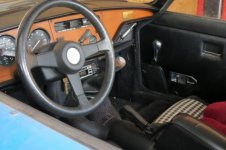After looking around for a while this "spring [hah!]" I decided to purchase an ugly duckling of a 1980 Spitfire. Its plus points are that the frame and undersides of the car are very clean and rust free for a New England car. It has a genuine 39,000 miles on the odometer. It even has the ugly houndstooth cloth seats and rubber bumpers.
It appears that I"m the second registered owner of the car, purchased today in the hills of western Maine. The current owner, a mechanic in the same town, purchased it about a year ago but never registered the car. He performed some basic engine work, greased and lubed parts, and kept it in his shop over this past winter; prior, it had been stored in a local barn during the winters.
The minus sides are annoyances: the blinkers and four-way flashers do not function, although the brake, headlights, parking lights and taillights work. The gas gauge remains at 1/4 full. When I took it out for a test drive the brakes were very poor; checking the reservoir revealed next to no fluid. The header/exhaust pipe connection is a weld that's developed a leak. The soft top is present but the rear window is torn at the base. The hardtop is an aftermarket "Snug Top." The tie rod ends are well greased but with torn boots.
With the bonnet up the mechanic watched the front brake hoses move slightly when I pumped the brakes. He saw wetness behind the right rear wheel so he'll replace that wheel cylinder, bleed the brakes and double check the brake lines. He's also weld up the header/pipe connection. I should be able to pick the car up before the end of the month.
Any thoughts on the annoyances mentioned above?
Thanks!
Jeff



It appears that I"m the second registered owner of the car, purchased today in the hills of western Maine. The current owner, a mechanic in the same town, purchased it about a year ago but never registered the car. He performed some basic engine work, greased and lubed parts, and kept it in his shop over this past winter; prior, it had been stored in a local barn during the winters.
The minus sides are annoyances: the blinkers and four-way flashers do not function, although the brake, headlights, parking lights and taillights work. The gas gauge remains at 1/4 full. When I took it out for a test drive the brakes were very poor; checking the reservoir revealed next to no fluid. The header/exhaust pipe connection is a weld that's developed a leak. The soft top is present but the rear window is torn at the base. The hardtop is an aftermarket "Snug Top." The tie rod ends are well greased but with torn boots.
With the bonnet up the mechanic watched the front brake hoses move slightly when I pumped the brakes. He saw wetness behind the right rear wheel so he'll replace that wheel cylinder, bleed the brakes and double check the brake lines. He's also weld up the header/pipe connection. I should be able to pick the car up before the end of the month.
Any thoughts on the annoyances mentioned above?
Thanks!
Jeff





 Hi Guest!
Hi Guest!

 smilie in place of the real @
smilie in place of the real @
 Pretty Please - add it to our Events forum(s) and add to the calendar! >>
Pretty Please - add it to our Events forum(s) and add to the calendar! >> 
